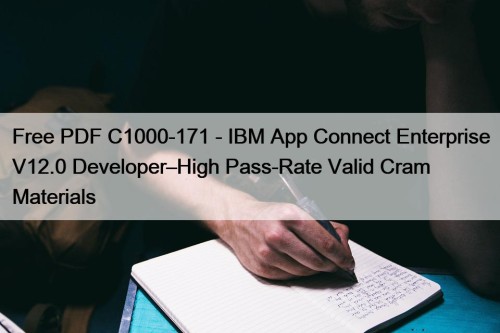Most Popular
 Free PDF C1000-171 - IBM App Connect Enterprise V12.0 Developer–High Pass-Rate Valid Cram Materials
Free PDF C1000-171 - IBM App Connect Enterprise V12.0 Developer–High Pass-Rate Valid Cram Materials
Our web-based practice exam software is an online version of ...
 Interesting Facts that Help you Crack the Tough VMware 2V0-13.24 Exam
Interesting Facts that Help you Crack the Tough VMware 2V0-13.24 Exam
As practice makes perfect, we offer three different formats of ...
 Get the Right Q&A in ACFE CFE Exam Questions
Get the Right Q&A in ACFE CFE Exam Questions
P.S. Free 2025 ACFE CFE dumps are available on Google ...



Interesting Facts that Help you Crack the Tough VMware 2V0-13.24 Exam

As practice makes perfect, we offer three different formats of VMware 2V0-13.24 exam study material to practice and prepare for the VMware Cloud Foundation 5.2 Architect (2V0-13.24) exam. Our VMware 2V0-13.24 practice test simulates the real 2V0-13.24exam and helps applicants kill exam anxiety. These 2V0-13.24 practice exams provide candidates with an accurate assessment of their readiness for the 2V0-13.24 test.
Competition has a catalytic effect on human development and social progress. Competition will give us direct goals that can inspire our potential and give us a lot of pressure. We must translate these pressures into motivation for progress. This road may not be easy to go. But with our 2V0-13.24 Exam Questions, you can be the most competitive genius in your field with the least time and efforts. As long as you follow with our 2V0-13.24 study guide, you will succeed for sure. Just come and try our 2V0-13.24 practice braindumps!
>> 2V0-13.24 Latest Exam Registration <<
2V0-13.24 New Real Test, 2V0-13.24 Exam Overview
We provide the VMware 2V0-13.24 exam questions in a variety of formats, including a web-based practice test, desktop practice exam software, and downloadable PDF files. ActualTorrent provides proprietary preparation guides for the certification exam offered by the 2V0-13.24 Exam Dumps. In addition to containing numerous questions similar to the 2V0-13.24 exam, the VMware Cloud Foundation 5.2 Architect (2V0-13.24) exam questions are a great way to prepare for the VMware 2V0-13.24 exam dumps.
VMware Cloud Foundation 5.2 Architect Sample Questions (Q25-Q30):
NEW QUESTION # 25
An architect is designing a VMware Cloud Foundation (VCF)-based solution for a customer with the following requirement:
The solution must not have any single points of failure.
To meet this requirement, the architect has decided to incorporate physical NIC teaming for all vSphere host servers. When documenting this design decision, which consideration should the architect make?
- A. Each NIC team must comprise NICs from different physical NIC cards.
- B. Embedded NICs should be avoided for NIC teaming.
- C. Each NIC team must comprise NICs from the same physical NIC card.
- D. Only 10GbE NICs should be utilized for NIC teaming.
Answer: A
Explanation:
In VMware Cloud Foundation 5.2, designing a solution with no single points of failure (SPOF) requires careful consideration of redundancy across all components, including networking. Physical NIC teaming on vSphere hosts is a common technique to ensure network availability by aggregating multiple networkinterface cards (NICs) to provide failover and load balancing. The architect's decision to use NIC teaming aligns with this goal, but the specific consideration for implementation must maximize fault tolerance.
Requirement Analysis:
No single points of failure:The networking design must ensure that the failure of any single hardware component (e.g., a NIC, cable, switch, or NIC card) does not disrupt connectivity to the vSphere hosts.
Physical NIC teaming:This involves configuring multiple NICs into a team (typically via vSphere's vSwitch or Distributed Switch) to provide redundancy and potentially increased bandwidth.
Option Analysis:
A: Embedded NICs should be avoided for NIC teaming:Embedded NICs (integrated on the server motherboard) are commonly used in VCF deployments and are fully supported for NIC teaming. While they may have limitations (e.g., fewer ports or lower speeds compared to add-on cards), there is no blanket requirement in VCF 5.2 or vSphere to avoid them for teaming. The VMware Cloud Foundation Design Guide and vSphere Networking documentation do not prohibit embedded NICs; instead, they emphasize redundancy and performance. This consideration is not a must and does not directly address SPOF, so it's incorrect.
B: Only 10GbE NICs should be utilized for NIC teaming:While 10GbE NICs are recommended in VCF
5.2 for performance (especially for vSAN and NSX traffic), there is no strict requirement thatonly10GbE NICs be used for teaming. VCF supports 1GbE or higher, depending on workload needs, as long as redundancy is maintained. The requirement here is about eliminating SPOF, not mandating a specific NIC speed. For example, teaming two 1GbE NICs could still provide failover. This option is too restrictive and not directly tied to the SPOF concern, making it incorrect.
C: Each NIC team must comprise NICs from the same physical NIC card:If a NIC team consists of NICs from the same physical NIC card (e.g., a dual-port NIC), the failure of that single card (e.g., hardware failure or driver issue) would disable all NICs in the team, creating a single point of failure. This defeats the purpose of teaming for redundancy. VMware best practices, as outlined in the vSphere Networking Guide and VCF Design Guide, recommend distributing NICs across different physical cards or sources (e.g., one from an embedded NIC and one from an add-on card) to avoid this risk. This option increases SPOF risk and is incorrect.
D: Each NIC team must comprise NICs from different physical NIC cards:This is the optimal design consideration for eliminating SPOF. By ensuring that each NIC team includes NICs from different physical NIC cards (e.g., one from an embedded NIC and one from a PCIe NIC card), the failure of any single NIC card does not disrupt connectivity, as the other NIC (on a separate card) remains operational. This aligns with VMware's high-availability best practices for vSphere and VCF, where physical separation of NICs enhances fault tolerance. The VCF 5.2 Design Guide specifically advises using multiple NICs from different hardware sources for redundancy in management, vSAN, and VM traffic. This option directly addresses the requirement and is correct.
Conclusion:The architect should document thateach NIC team must comprise NICs from different physical NICcards (D)to ensure no single point of failure. This design maximizes network redundancy by protecting against the failure of any single NIC card, aligning with VCF's high-availability principles.
References:
VMware Cloud Foundation 5.2 Design Guide (Section: Networking Design)
VMware vSphere 8.0 Update 3 Networking Guide (Section: NIC Teaming and Failover) VMware Cloud Foundation 5.2 Planning and Preparation Workbook (Section: Host Networking)
NEW QUESTION # 26
Given a scenario, which design decision is required to leverage VMware Cloud Foundation (VCF) Lifecycle Management (LCM) in the design?
Response:
- A. Using a centralized identity management system for VCF LCM operations
- B. Integrating VCF LCM with a third-party backup solution
- C. Enabling automated patching and update management through VCF LCM
- D. Using VMware vSphere Distributed Switch for all network configurations
Answer: C
NEW QUESTION # 27
An architect is designing a VMware Cloud Foundation (VCF)-based Private Cloud solution. During the requirements gathering workshop with customer stakeholders, the following information was captured:
The solution must be capable of deploying 50 concurrent workloads.
The solution must ensure that once submitted, each service does not take longer than 6 hours to provision.
When creating the design documentation, which design quality should be used to classify the stated requirements?
- A. Manageability
- B. Availability
- C. Performance
- D. Recoverability
Answer: C
Explanation:
In VMware Cloud Foundation (VCF) 5.2, design qualities (or non-functional requirements) categorize how the solution meets its objectives. The requirements-"deploying 50 concurrent workloads" and"provisioning each service within 6 hours"-must be classified under a quality that reflects their intent. Let's evaluate each option:
Option A: AvailabilityAvailability ensures the solution is accessible and operational when needed (e.g., uptime percentage). While deploying workloads and provisioning services assume availability, the requirements focus onspeedandcapacity(50 concurrent workloads, 6-hour limit), not uptime or fault tolerance.
This quality doesn't directly address the stated needs, making it incorrect.
Option B: RecoverabilityRecoverability addresses the ability to restore services after a failure (e.g., disaster recovery). The requirements don't mention failure scenarios, backups, or restoration-they focus on provisioning speed and concurrency during normal operation. Recoverability is unrelated to these operational metrics, so this is incorrect.
Option C: PerformanceThis is the correct answer. Performance measures how well the solution executes tasks, including speed, throughput, and capacity. In VCF 5.2:
"Deploying 50 concurrent workloads" is a throughput requirement, ensuring the system can handle multiple deployments simultaneously.
"Each service does not take longer than 6 hours to provision" is a latency or response time requirement, setting a performance boundary.Both align with theperformancequality, which governs resource efficiency and user experience in provisioning workflows (e.g., via SDDC Manager or Aria Automation). This classification fits VMware's design framework.
Option D: ManageabilityManageability focuses on ease of administration, monitoring, and maintenance (e.
g., automation, UI simplicity). While provisioning workloads involves management, the requirements emphasizehow fastandhow many-performance metrics-not the ease of managing the process.
Manageability might apply to tools enabling this, but it's not the primary quality here.
Conclusion:The design quality to classify these requirements isPerformance(Option C). It directly reflects the solution's ability to handle 50 concurrent workloads and provision services within 6 hours, aligning with VCF 5.2's focus on operational efficiency.
References:
VMware Cloud Foundation 5.2 Planning and Preparation Guide (Section: Design Qualities) VMware Cloud Foundation 5.2 Architecture and Deployment Guide (Section: Performance Considerations)
NEW QUESTION # 28
Given a scenario, which two design decisions should be considered for workload migration into a VCF environment?
(Choose two)
Response:
- A. Ensuring the migration uses minimal storage capacity
- B. Configuring VMware HCX for cross-site migration
- C. Configuring multiple storage clusters to reduce network traffic
- D. Ensuring the migration process does not impact the production network
Answer: B,D
NEW QUESTION # 29
What is the best practice for securing VMware Cloud Foundation workloads against external threats?
Response:
- A. Using a firewall to block all external traffic to the VCF environment
- B. Relying on physical security of the data center to protect workloads
- C. Disabling all unnecessary services on virtual machines to reduce attack surface
- D. Configuring network security policies using VMware NSX to isolate workloads
Answer: D
NEW QUESTION # 30
......
ActualTorrent's 2V0-13.24 certification is a dispensable part in IT area. So how can we achieve it in a short time? ActualTorrent will be your choice. 2V0-13.24 test training materials of ActualTorrent are organized by experienced IT experts. If you still worry, you can download 2V0-13.24 free demo before purchase.
2V0-13.24 New Real Test: https://www.actualtorrent.com/2V0-13.24-questions-answers.html
With the help of the 2V0-13.24 valid training material, you head will be set free and be more confident to face the exam, Start Learning VMware 2V0-13.24 Exam Questions For Excellent And Quality Results, VMware 2V0-13.24 provides you with real-time VMware 2V0-13.24 exam environment for preparation, With our 2V0-13.24 exam guide, all your learning process includes 20-30 hours.
Our VMware 2V0-13.24 study materials have the most favorable prices, Customize views to meet unique drawing or interaction requirements, With the help of the 2V0-13.24 valid training material, you head will be set free and be more confident to face the exam.
Complete Study Guide your ultimate companion for 2V0-13.24 Prep
Start Learning VMware 2V0-13.24 Exam Questions For Excellent And Quality Results, VMware 2V0-13.24 provides you with real-time VMware 2V0-13.24 exam environment for preparation.
With our 2V0-13.24 exam guide, all your learning process includes 20-30 hours, Also, upon purchase, the candidate will be entitled to 1 year free updates, which will help candidates to stay up-to-date with 2V0-13.24 news feeds and don't leave any chance which can cause their failure.
- New 2V0-13.24 Test Braindumps 📅 Braindump 2V0-13.24 Pdf 🐆 2V0-13.24 Free Braindumps 🚞 Search for “ 2V0-13.24 ” and obtain a free download on ▷ www.prep4away.com ◁ 🐠Reliable 2V0-13.24 Test Braindumps
- 2V0-13.24 Latest Exam Registration|Handy for VMware Cloud Foundation 5.2 Architect 🎬 Search for ➡ 2V0-13.24 ️⬅️ and download it for free immediately on 《 www.pdfvce.com 》 🛣2V0-13.24 Reliable Exam Papers
- New 2V0-13.24 Test Braindumps 🤽 Latest 2V0-13.24 Exam Vce 🥃 Accurate 2V0-13.24 Test 🎧 Go to website “ www.real4dumps.com ” open and search for [ 2V0-13.24 ] to download for free 📮2V0-13.24 Valid Test Camp
- 2V0-13.24 Download Pdf 🙆 2V0-13.24 Valid Test Camp 🐯 2V0-13.24 Free Braindumps 🚺 Open ▛ www.pdfvce.com ▟ and search for ✔ 2V0-13.24 ️✔️ to download exam materials for free 🧫Accurate 2V0-13.24 Test
- Free PDF Quiz VMware - 2V0-13.24 - Fantastic VMware Cloud Foundation 5.2 Architect Latest Exam Registration 🥉 Search for ☀ 2V0-13.24 ️☀️ and download it for free immediately on [ www.vceengine.com ] 📔Reliable 2V0-13.24 Test Braindumps
- 2V0-13.24 New Exam Materials 🖋 Practice 2V0-13.24 Engine 🐂 2V0-13.24 Valid Exam Guide 🧦 Copy URL ⇛ www.pdfvce.com ⇚ open and search for ☀ 2V0-13.24 ️☀️ to download for free 🤓2V0-13.24 New Exam Materials
- Trustworthy 2V0-13.24 Practice 🟪 Accurate 2V0-13.24 Test 🤖 Latest 2V0-13.24 Test Pass4sure 🚁 Enter 《 www.exam4pdf.com 》 and search for 「 2V0-13.24 」 to download for free 🚂New 2V0-13.24 Test Cram
- Useful 2V0-13.24 Dumps ✴ Latest 2V0-13.24 Test Pass4sure 🛒 2V0-13.24 New Exam Materials ⏲ Go to website “ www.pdfvce.com ” open and search for ▶ 2V0-13.24 ◀ to download for free 🚢Reliable 2V0-13.24 Test Braindumps
- 2V0-13.24 Valid Test Camp 😗 Reliable 2V0-13.24 Test Braindumps 🆕 2V0-13.24 Valid Exam Guide 💑 Download ➡ 2V0-13.24 ️⬅️ for free by simply entering ▷ www.free4dump.com ◁ website 🤚New 2V0-13.24 Test Braindumps
- 2V0-13.24 New Exam Materials 💼 2V0-13.24 Latest Exam Review 🔤 Trustworthy 2V0-13.24 Practice ✒ [ www.pdfvce.com ] is best website to obtain ⏩ 2V0-13.24 ⏪ for free download 🍒Practice 2V0-13.24 Engine
- 2V0-13.24 New Exam Materials 🔀 Latest 2V0-13.24 Test Pass4sure 🏪 Braindump 2V0-13.24 Pdf 🍌 Simply search for ➤ 2V0-13.24 ⮘ for free download on ⮆ www.examdiscuss.com ⮄ 🟦2V0-13.24 Authorized Certification
- 2V0-13.24 Exam Questions
- mekkawyacademy.com www.camcadexperts.com digitalmamu.com civilconstruct.in yogasangrah.com bma.co.mz lms.alhikmahakademi.com englexis.com a1ta.ca 水晶天堂區域.官網.com
Tags: 2V0-13.24 Latest Exam Registration, 2V0-13.24 New Real Test, 2V0-13.24 Exam Overview, Vce 2V0-13.24 Free, 2V0-13.24 Free Practice Exams